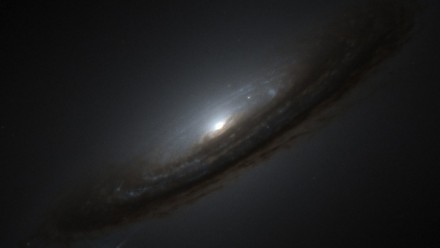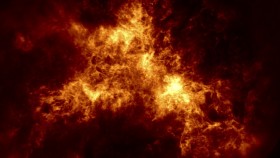By the light of exploding stars
ANU ScienceWise Magazine - Astronomy special edition
On casually glancing into the night sky, one might imagine that the brightest stars are the closest and dimmer ones are more remote. However the inherent brightness of stars varies by a factor of many millions, depending on their age, mass and other characteristics. The closest star to the Earth (other than the Sun) is Proxima Centauri – a dim dwarf completely invisible to the naked eye, yet the second brightest star in the entire sky, Canopus, is almost a hundred times more distant than Proxima.
For these reasons, establishing the scale of the universe is a far from simple task and the first accurate measurements of stellar distances were not made until the nineteenth century. These used a method called parallax, based on the 300 million kilometre difference in the Earth’s position as it orbits the Sun. This changing viewpoint causes stars that are fairly close to the Earth to appear to shift slightly against the background of far more distant stars. The shift is tiny, but measurable. The nice thing about parallax is that it is a simple and therefore reliable geometric measurement but it only works for relatively close objects. For greater distances, astronomers must rely on what are known as ‘standard candles’ – that is objects whose inherent brightness is known, or at least believed to be known. If you know how bright something really is and you can measure how bright it appears, you can work out the distance by the inverse square law.
One useful set of standard candles are Cepheid variable stars. In the late nineteenth century, Henrietta Swan Leavitt studied Cepheids that form part of the Large Magellanic Cloud – a small satellite galaxy of the Milky Way. Because they were all in one galaxy and therefore all at essentially the same distance, she was able to accurately estimate their absolute brightness relative to each other. She noticed that there is a direct relationship between how intrinsically bright a Cepheid is and its period. This means that by measuring the apparent brightness and periods of Cepheids, astronomers can determine their distance far beyond the range of parallax. However, even the most distant Cephieds observable are not that far away in cosmic terms. For huge distances, astronomers have to use brighter and more distant standard candles such as entire galaxies, though the absolute brightness of such objects is not known with nearly the same certainty as that of Cepheids.
In the early twentieth century, with the advent of spectroscopy, astronomers were able to measure both the distance and the relative velocity of objects by observing how far their light was red shifted by the Doppler effect. By combining the distance and velocity information astronomers concluded that almost everything in the universe is receding from us. Edwin Hubble, after whom the famous space telescope is named, noticed that the greater the distance of an object, the faster the object seems to be moving away.
Knowing the velocities and distances of stars and galaxies, one can extrapolate back to the big bang and in this way, estimate an age for the universe. Having done this, a natural question to ask would be what will happen in the future? Will the combined gravity of all the matter in the universe eventually slow the expansion enough to collapse everything back to a big crunch, or will the universe expand forever?
This is a question that fascinates Professor Brian Schmidt of the ANU Research School of Astronomy and Astrophysics. To answer it, Professor Schmidt’s research group have been measuring the velocities and distances of objects at far greater distances than that at which Cepheid variables could be observed. Entire galaxies can be used as standard candles and can be seen at great distances but it’s hard to be sure about their inherent brightness, which in turn makes estimating their distance unreliable. To get around this, the group focused their attention on what are known as type Ia supernovae.
A type Ia supernova can occur in stars similar to the Sun. These are not massive enough to enable gravity to compress and heat the core past the point of burning its nuclear fuel to carbon and oxygen. Since iron is the lowest point in nuclear potential, such stars still contain massive amounts of nuclear fuel when the reactions stop. However, if the star is part of a binary pair, it can continue to siphon material off its companion once its own reactions cease, growing in mass until a critical point is reached where gravitational contraction enables carbon and oxygen to begin to fuse into heavier elements. Once this process begins to happen, it happens all at once, like in a nuclear bomb - liberating a huge amount of energy in a short time.
The special thing about type Ia supernovae is that they only occur in stars within quite narrow mass ranges which in turn means that they are all of similar brightness when they explode. This, coupled with their huge brightness, make them ideal as standard candles for extreme distances.
The group have been studying these supernovae for several years and having analysed their data, have come to the surprising conclusion that far from slowing down, the rate of expansion of the universe is actually speeding up. This counter intuitive scenario would have seemed almost inconceivable a few years ago. Professor Schmidt explains that our observations may really mean one of three things:
-
The Exciting: the Universe is accelerating. The Universe is accelerated by some unknown type of matter that is spread throughout the Cosmos.
-
The Heretical: General Relativity is as sacred as anything in Physics, but it may be wrong. Since our work is comparing the predictions of General Relativity with observations, if General Relativity is wrong, so are our conclusions.
-
The Mundane (at least from our point of view): We are simply wrong and have been fooled by supernovae into believing the Universe is accelerating. Maybe supernovae are fainter in the past, and therefore look further away.
“We hope and believe it’s the first alternative, but we have to work hard and test to see if it isn’t the second or third. Checking these two other alternatives is a major focus of our current work”.















